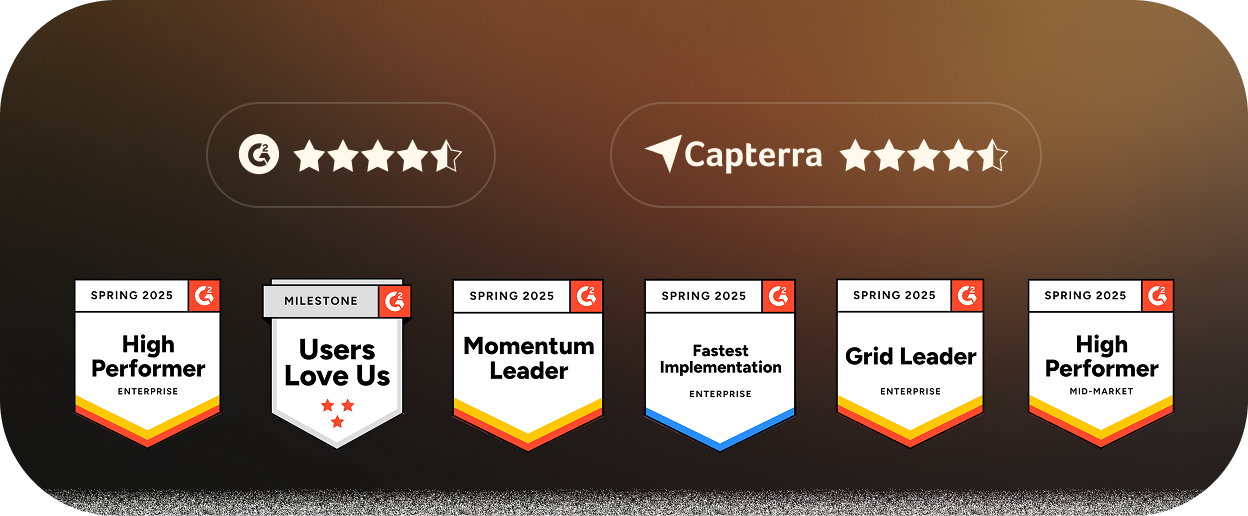
Premios de reconocimiento
Las recompensas de agradecimiento son una forma eficaz de que las organizaciones reconozcan y celebren los esfuerzos de los empleados, ya sean grandes o pequeños. Estas recompensas -que van desde un simple agradecimiento hasta bonificaciones monetarias- refuerzan el comportamiento positivo, elevan la moral y crean una cultura de reconocimiento.
Cuando se entregan de forma meditada y sistemática, las recompensas pueden mejorar la satisfacción de los empleados, reforzar la dinámica de equipo y aumentar la productividad general en el lugar de trabajo. Este glosario explica qué son las recompensas de agradecimiento, por qué son importantes, cuándo y cómo utilizarlas, los retos habituales y cómo medir su impacto de forma eficaz.
¿Qué son las recompensas de agradecimiento?
Las recompensas de agradecimiento son obsequios no monetarios o monetarios que se dan a los empleados para reconocer su esfuerzo, actitud o logros en el trabajo. Estas recompensas demuestran que la organización valora y reconoce sus contribuciones.
¿Cuáles son los distintos tipos de recompensas por agradecimiento?
Las recompensas de agradecimiento pueden adoptar diversas formas, en función del modo en que la empresa decida reconocer las contribuciones de los empleados. Pueden ser monetarias, no monetarias o centradas en el crecimiento.
- Las recompensas monetarias incluyen bonificaciones, tarjetas regalo o incentivos al rendimiento que ofrecen un valor financiero directo.
- Las recompensas no monetarias implican el reconocimiento público, notas de agradecimiento o certificados que muestran aprecio sin coste monetario.
- Las recompensas experienciales ofrecen experiencias memorables, como salidas en equipo o días de permiso adicionales.
- Las recompensas basadas en la carrera profesional se centran en el crecimiento, como oportunidades de formación, tutorías o ascensos.
- El reconocimiento entre iguales permite a los empleados apreciarse mutuamente mediante herramientas o gritos informales.
¿Por qué son importantes las recompensas?
Hacen que los empleados se sientan valorados, aumentan su motivación y refuerzan su conexión emocional con la organización. Cuando las personas se sienten apreciadas, es más probable que mantengan su compromiso y sean más productivas.
- Mejorar el compromiso y la satisfacción laboral de los empleados
- Reducir la rotación de personal y aumentar los índices de retención
- Reforzar los comportamientos deseados y los valores de la empresa
- Fomentar una cultura positiva y colaborativa en el lugar de trabajo
¿Cuándo deben darse las recompensas de agradecimiento?
El momento es importante. El reconocimiento es más eficaz cuando se da con prontitud y coherencia. Las recompensas pueden formar parte de programas estructurados o de agradecimientos espontáneos.
- Tras la finalización de proyectos importantes o hitos de rendimiento
- Durante los días de agradecimiento a los empleados o las celebraciones del equipo
- En cumpleaños, aniversarios laborales o hitos personales
- Para las pequeñas acciones cotidianas que contribuyen al éxito del equipo
¿Dónde se utilizan las recompensas?
Las recompensas de agradecimiento se utilizan en diversos entornos de trabajo -oficinas corporativas, nuevas empresas, unidades de fabricación, equipos remotos y configuraciones híbridas- para promover una cultura de reconocimiento.
- En plataformas de comunicación interna como Slack o Teams
- Durante reuniones públicas, revisiones de rendimiento o reuniones de equipo
- A través de software de reconocimiento de empleados o plataformas de recompensas
- Mostrado públicamente mediante boletines o anuncios en la intranet
¿Quién concede las recompensas?
El reconocimiento puede provenir de distintos niveles: directivos, compañeros, RR.HH. o líderes. Muchas organizaciones fomentan el reconocimiento entre iguales para crear un sentimiento de comunidad más fuerte.
- Gerentes y jefes de equipo que reconocen a sus subordinados directos
- Equipos de RRHH o de liderazgo que inician el reconocimiento en toda la empresa
- Sistemas entre iguales que permiten a los colegas apreciarse mutuamente
- Herramientas automatizadas que activan recompensas en función de las métricas de rendimiento.

Encuestas sobre el pulso de los empleados:
Se trata de encuestas breves que pueden enviarse con frecuencia para comprobar rápidamente lo que piensan sus empleados sobre un tema. La encuesta consta de menos preguntas (no más de 10) para obtener la información rápidamente. Pueden administrarse a intervalos regulares (mensual/semanal/trimestral).

Reuniones individuales:
Celebrar reuniones periódicas de una hora de duración para mantener una charla informal con cada miembro del equipo es una forma excelente de hacerse una idea real de lo que les pasa. Al tratarse de una conversación segura y privada, te ayuda a obtener mejores detalles sobre un asunto.

eNPS:
eNPS (employee Net Promoter score) es una de las formas más sencillas y eficaces de evaluar la opinión de sus empleados sobre su empresa. Incluye una pregunta intrigante que mide la lealtad. Un ejemplo de preguntas de eNPS son ¿Qué probabilidades hay de que recomiende nuestra empresa a otras personas? Los empleados responden a la encuesta eNPS en una escala del 1 al 10, donde 10 significa que es "muy probable" que recomienden la empresa y 1 significa que es "muy improbable" que la recomienden.
En función de las respuestas, los empleados pueden clasificarse en tres categorías diferentes:

- Promotores
Empleados que han respondido positivamente o están de acuerdo. - Detractores
Empleados que han reaccionado negativamente o no están de acuerdo. - Pasivos
Empleados que se han mantenido neutrales con sus respuestas.
¿Cómo funcionan las recompensas?
Funcionan reconociendo a los empleados de forma oportuna y significativa. El agradecimiento eficaz es específico, está vinculado a una acción o resultado claro y se entrega de una forma que se adapta a la cultura de la empresa.
- Identificar qué comportamiento o logro se está reconociendo
- Elija la recompensa adecuada (verbal, digital o física)
- Entregar la recompensa a través del canal adecuado (correo electrónico, plataforma, evento)
- Seguimiento del impacto para mejorar los futuros esfuerzos de reconocimiento



.svg)






















































.svg)
.svg)

.svg)

.svg)
.svg)
.svg)

.svg)
.svg)
.svg)
.svg)
.svg)
















































































